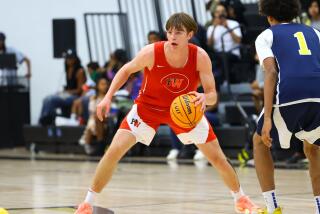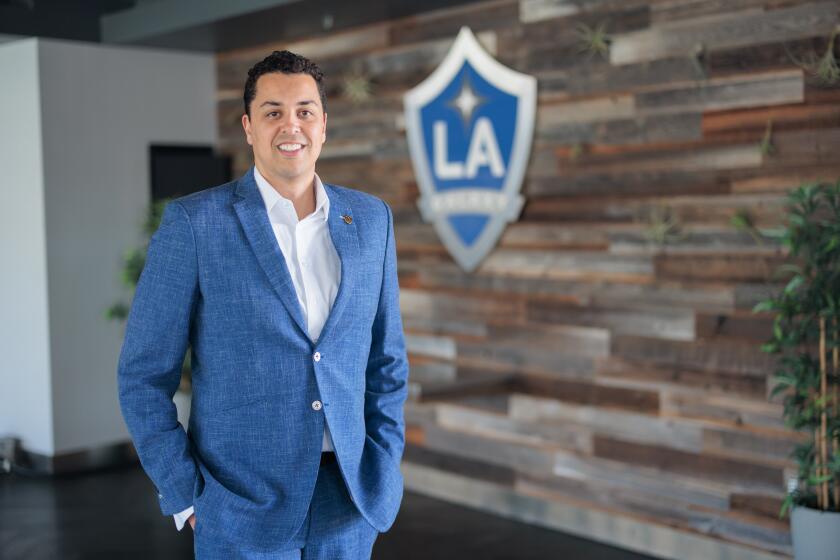Playing in high school is no longer vital for college scholarship seekers
There has been a longtime assumption, if not an unwritten commandment, in the world of high school sports: Thou shall play for your high school team if you want to be spotted by a college recruiter and offered a scholarship.
Donât tell that to Palm Desert High senior Tanner Rahier. He is a shortstop bound for the University of San Diego who hasnât played high school baseball since his freshman year.
âIf you have the talent, theyâll find you,â Rahier said.
Rahier is an example of the changing landscape in college recruiting. He gave up high school baseball to play in a San Bernardino-based spring league run by an academy. And he played for a travel team that went to Jupiter, Fla., in the summer of 2010, which is when a San Diego recruiter saw him.
With few exceptions, playing high school sports is no longer considered a vital pathway toward obtaining a college sports scholarship. College recruiters are relying more on club competitions, combines, camps and showcases to identify the majority of their recruited athletes.
Changes in NCAA recruiting rules, combined with the idea that the best and most efficient way to evaluate players is when they compete in all-star events, has made high school sports competition almost irrelevant for college recruiters in certain sports.
Golfers are scouted and recruited off their play in American Junior Golf Assn. tournaments. In tennis, the major events for boys and girls are in August when the USTA junior championships are held.
Kelly Inouye Perez, the softball coach for 11-time NCAA champion UCLA, said she âcanât rememberâ the last time she attended a high school softball practice to evaluate a prospect.
âItâs all about travel ball and watching summer training,â she said.
John Speraw, menâs volleyball coach at UC Irvine, said he occasionally attends high school matches but added, âMost of the identification comes through the club program. We get to see them playing against the best, and we evaluate their potential.â
Denise Corlett, assistant coach for the womenâs volleyball team at Stanford, said, âOnce or twice a year, weâll go to a high school match of a kid weâre trying to recruit. You see them enough during the club season.â
Since 2009, top boysâ soccer players in Southern California have been abandoning high school programs after a developmental academy league was formed by U.S. Soccer. Club programs have pressured their players to make a choice â high school or club. Four-time City Section champion Woodland Hills El Camino Real has lost at least 10 players to club teams, Coach David Hussey said.
One of those players was Ericson Penate, who didnât play for the Conquistadores last season because his club team, Real SoCal, is part of the academy program and trains and plays tournaments during the high school season.
Released from his academy team, Penate is playing for El Camino Real this season as a senior.
âItâs either youâre on the club team or play high school,â Penate said. âThe coaches tell me I have a better chance to go somewhere with academy than high school.â
College coaches focus their recruiting on big events to identify players. For soccer, itâs the Surf Cup at the San Diego Polo Club on July 28-30. For girlsâ volleyball, itâs a tournament in Las Vegas in February during Presidentâs Day weekend. For boysâ volleyball, itâs the Junior Olympics in July. For softball, itâs the ASA championships in July.
Three sports â football, basketball and baseball â are still clinging to relevancy at the high school level thanks to NCAA recruiting rules that bar coaches from evaluating athletes during certain key periods of the year, making it difficult for club programs to gain a permanent foothold.
Football coaches canât visit schools to evaluate prospects during the summer. Basketball coaches canât watch players who arenât in high school-sanctioned events during the prep season. Baseball coaches canât watch players from early November through the last day in February.
But those sports are slowly tipping in the direction of the Olympic sports because of the increasing importance put on summer competition.
In basketball, thereâs growing emphasis among college recruiters to identify top prospects through their spring and summer club teams and performances at elite camps. The fact that players are being identified as prospects in seventh and eighth grade has added to the reliance on non-high school competitions. Tournaments held in July in Las Vegas are attended by so many college coaches that they could hold a convention.
In baseball, summer showcases and tournaments keep expanding, resulting in college coaches traveling around the country to evaluate prospects at such events as the Area Code Games in Long Beach, the Junior Olympics in Arizona and the USA 18U and 16U trials in North Carolina.
In football, the NCAA prohibits coaches from attending high school combines in June and July, so the major focus is on encouraging top prospects to attend camps on college campuses. Recruiters say that way they can get to know players personally while seeing firsthand how they measure up against other top competition.
The summer has evolved into a Kabuki dance in which the main characters are supposed to be competitors but in reality are working in concert to cash in on the recruiting process.
Perfect Game charges more than $500 to have players participate in its baseball showcases around the country. Nike and Adidas help sponsor camps and tournaments, drawing large numbers of college coaches who pay entry fees to watch and obtain names, addresses and phone numbers of prospects. Scout.com, Rivals.com, ESPN.com, Baseball America and others send writers and talent evaluators to combines, camps and showcases to hype up prospects and feed the appetites of readers who seemingly can never get enough information about where a prospect might be headed for college or the pros.
âThe recruiting game is a business, and the athletes are the product,â said Eric Horvat, a former Cal State Northridge baseball player who started a sports marketing company, DirectProspect.com. âThe athletic world is so different from 10 years ago. Grab your smart phone, take a quick video, upload it on your YouTube channel. Bam! Any coach in the nation can find you with a Google search. I couldnât do something like that when I was playing.â
Thanks to advances in technology, sharing game film is as easy as making a phone call. Individual schools have hired companies such as Hudl to be able to exchange video quickly and easily via the Internet. Itâs all leading to increased exposure for athletes.
Coaches see some advantages to this new age in recruiting. But there are also concerns about the loss of the high school experience.
âThereâs so much value in City championships, CIF championships and Friday afternoon games on campus and facing those bitter rivals,â UCLA baseball Coach John Savage said. âYou canât undervalue what the high school coaches teach. Heâs there with the player every day. Some of our best resources are the high school coach, and anyone who doesnât think so is missing the boat.â
Bob Cantu, assistant basketball coach at USC, said, âSummer stuff is great to evaluate a lot of kids at one time, but ultimately you evaluate a kid from high school practice and games. Being able to see a kid in a more structured environment is important, seeing how they respond to winning or losing when youâre representing your high school competing for a state or regional championship. For me to determine if a kid can play for us, I have to be able to evaluate from his high school.â
Gary Bernardi, an assistant football coach at San Jose State, said, âIf you talk to veteran recruiters, they still rely on the high school coach. In 31 years, Iâve never relied on anyone more than the high school coach. Maybe Iâm a dinosaur, but the guys I bring in are pretty decent players, theyâre good citizens and they graduate.â
But itâs clear there are many more options for teenage athletes on how to proceed and who to rely on to develop their sports skills.
Rahier, 6 feet 2 and 210 pounds, took an uncharted road after starting as a freshman for Palm Desert. He gave up high school baseball to join an academy that played its season at the same time as the high school season.
âIâm out in the Coachella Valley,â he said. âItâs Division 4 baseball. I saw all the talent and I was like, âThis is Southern California. This is supposed to be the best baseball in the nation.â We were thinking of moving to a Division 1 high school to get better competition. [Then] I found out about the spring league. It turned out to be great. I played 60 games with a wood bat.â
San Diego Coach Rich Hill said âeyebrows were raisedâ when he learned Rahier didnât play high school baseball.
âWe wanted to dig in and do research,â he said.
What the coach found was a teenager with aspirations of playing pro ball who decided he wanted to face better competition.
âItâs tough for old-school guys because high school baseball meant so much to us,â Hill said.
Rahier missed out on lots of things by not playing for Palm Desert, which won a Southern Section championship in 2010 and played at Dodger Stadium last season. But he has no regrets.
âIâm still friends with players and coaches,â he said. âIt depends on how serious you are. It was a serious choice for me. It was a new thing. People asked, âNo one else does it, why are you doing it?â Theyâre seeing my performance and how Iâm advancing. I think in 10 years, this is going to be the new high school baseball.â
Others are not so sure about giving up on the high school experience.
âIt changes the whole landscape of the sport, where itâs often individualized,â USC baseball Coach Frank Cruz said. âYou donât care if you win or lose. Youâre trying to throw 90 mph and run fast. People tend to dismiss the team game, and I donât think thatâs good for the game.â
USC football Coach Lane Kiffin said high school games remain âthe No. 1 evaluation tool.â
âGame film. Thatâs real ball with pads on,â Kiffin said. âAll of the other stuff is part of a process. But our No. 1 thing that weâre always going to go back to in evaluations is game film.â
However, the train has already left the station for sports such as softball, where Ellie Manriquez began playing travel ball when she was 10 in the San Gabriel Valley. She signed with Appalachian State, which is 2,336 miles from her high school, Alhambra Ramona Convent.
âA scout told me it doesnât matter what high school you go to,â said Manriquezâs mother, Kristen Villa. âWhat matters is the travel ball team.â
Staff writer Gary Klein contributed to this story.
More to Read
Go beyond the scoreboard
Get the latest on L.A.'s teams in the daily Sports Report newsletter.
You may occasionally receive promotional content from the Los Angeles Times.











